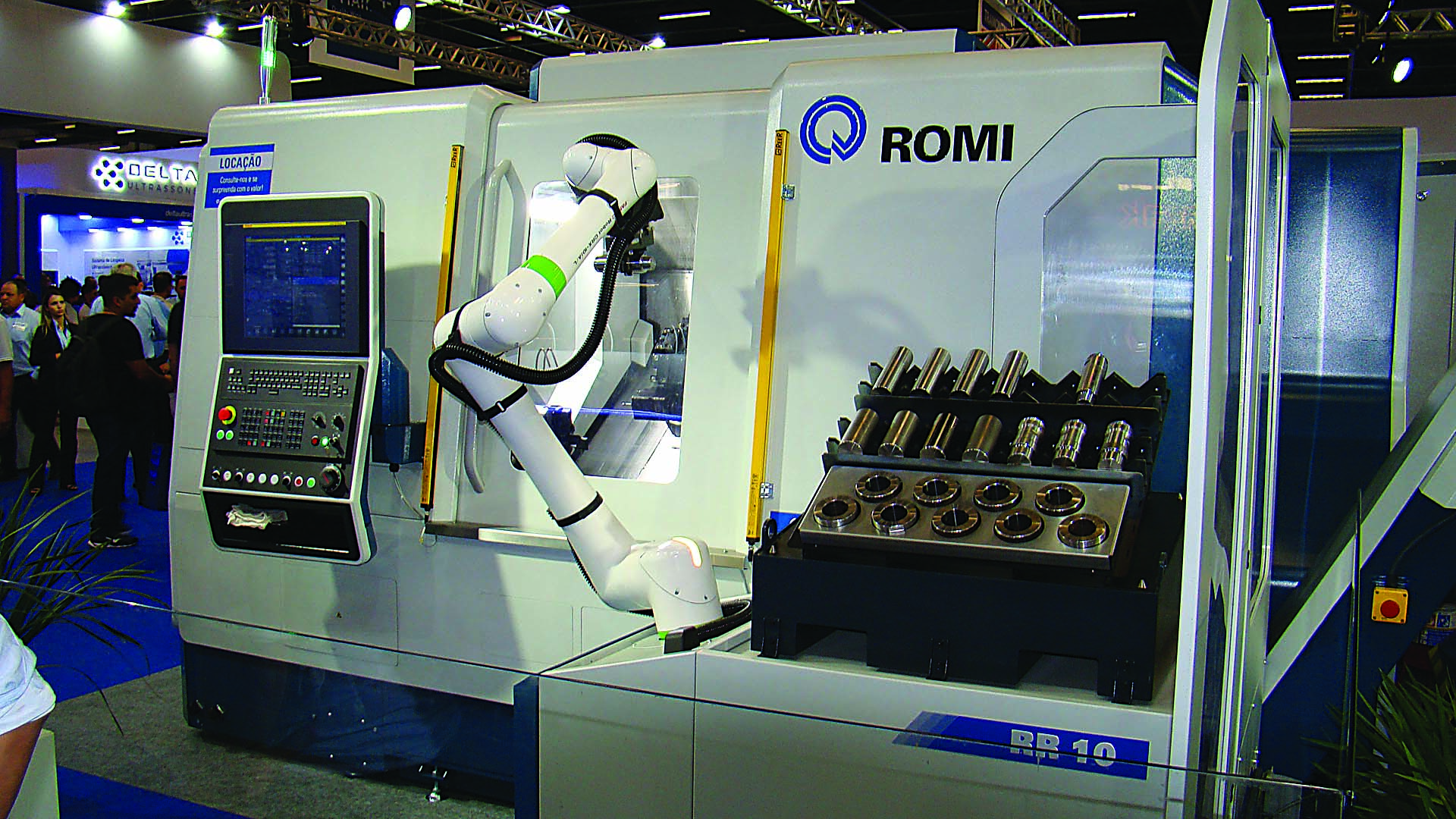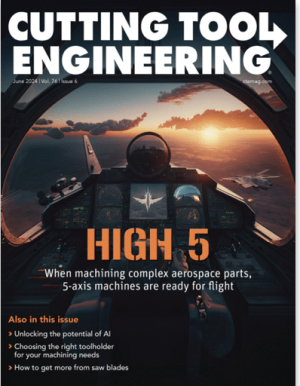When it comes to major international manufacturing and metalworking trade shows, North America has IMTS, Europe has EMO, Asia has JIMTOF and Latin America has FEIMEC.
The fourth edition of the biennial and Brazilian-based Feira Internacional de Máquinas e Equipmentos, or International Machinery and Equipment Exposition, took place May 7-11 at the São Paulo Expo Exhibition & Convention Center. An initiative of ABIMAQ (Brazilian Association of the Machinery and Equipment Industry) and promoted and organized by Informa Markets Latam, FEIMEC 2024 featured more than 1,100 exhibitors from 37 countries, with some 400 companies on the waiting list, and attracted more than 65,000 visitors, according to show organizers.
This Chicago-based trade magazine editor was invited by Brazil Machinery Solutions (BMS), an export incentive program for Brazilian machinery and equipment industries, to attend the event along with an editor from Mexico and one from South Africa.
“With each edition, FEIMEC consolidates itself as a hub for generating knowledge, experiences, networking and business opportunities, thanks to the trust of thousands of companies in the event’s potential to bring together and encourage commercial partnerships across various segments represented here,” stated Marco Basso, chairman of Informa Markets, in his welcome message.
Presented here is a roundup of the various exhibits visited in connection with the BMS’ Industry Image Project.

Santa Bárbara d’Oeste-headquartered Romi S.A.’s stand in the center of the exhibition hall displayed a variety of its CNC machine tools, such as the 5-axis DCM 620-5F that allows machining of parts with simple and complex geometries in a single setup. Rafael Boldorini, general manager – overseas, said Romi builds about 2,200 machines annually at its facilities in Brazil and Germany, with roughly 70% sold in Brazil. The 94-year-old company has eight subsidiaries, including Romi Machine Tools Ltd. in Erlanger, Kentucky. Romi provides direct sales in Kentucky, Ohio and Indiana, while selling through distributors in the other states. Boldorini noted that the Centur 35 lathe is the best seller in the U.S.
Another machine tool builder that was visited was São Paulo-based Ergomat Indústria e Comércio Ltda. A featured machine at the exhibit was the A 25 E automatic lathe, which enables up to five simultaneous tools in a part. The design of the cam-operated screw machine was developed in the 1940s, said Tadeu Marcelino, foreign trade manager for Ergomat, adding that the “purely mechanical” machine is faster than a CNC one and is well-suited for high-volume production of cylindrical parts with short cycle times. Those parts include bullets, bone screws, manifolds and connections. CNC machines were also displayed, such as the TBA 65 Next multiple-carriage CNC automatic lathe for complete machining in one setup using the subspindle and the TNG 42 universal CNC automatic lathe with a “gang” toolholder table with up to 10 positions for short chip-to-chip times.
At the Grupo Dosivac do Brasil’s exhibit, Operations Manager Anderson A. Santos discussed the diaphragm and piston dosing pumps for chemical injection offered by the company, which is in São Bernardo do Campo in the state of São Paulo. The market segments the company serves include machine manufacturers, onshore oil companies, sugar and alcohol plants, the steel industry, public and private sanitation, and food, paper and cellulose production facilities.
For moving cables that need protection, Porta Cabos Indústria e Comércio Ltda., also based in São Bernardo do Campo, produces metallic and nylon cable carriers. Business Manager Ricardo Carvalho said the company serves multiple industries and applications include protecting and prolonging cables in mining equipment, maintenance machines and robots with irregular movements. “Cables are the heart of the machine.” He added that the company is experiencing growth as various types of equipment continues migrating from manual to automated operation.
On exhibit at Eletrothermo Comércio e Indústria Ltda.’s booth were infrared heaters for applications such as thermoforming plastics, sintering tools and drying paint, glue and technical ceramics with a temperature up to 800° C (1,472° F), explained Ricardo de Oliveria Sandes, administrator at the Itaquaquecetuba, São Paulo-based company. Eletrothermo’s customers include a variety of automakers and airplane manufacturer Embraer. He added that the company’s industrial heating products help conserve energy.
Ringfeder Power Transmission GmbH is headquartered in Gross-Umstadt, Germany, and Jaboticabal, São Paulo-based Henfel Indústria Metalúrgica Ltda. hosted its exhibit, which featured couplings, shaft-hub connections and damping technology. Renan Orlandi, external sales leader at Henfel, said Ringfeder acquired Henfel about a decade ago, and the company’s production facilities include a foundry, a machine shop with about 40 CNC machines, a quality control department and paint booths.
Last but not least was São Paulo-based HB Solucões em Ar Comprimido Ltda.’s exhibit, which featured products for air and other compressed gases. Director Jayme M. Bydlowski discussed the company’s compress air filters to remove water, dirt and oil. Customers include hospitals, bottle manufacturers and machine shops — anywhere clean air is needed.
In addition, the editorial group spoke with Rogério Bosco, president of CSMF (Sector Chamber of Machine Tools and Integrated Manufacturing Systems). When asked about the state of Industry 4.0 initiatives by Brazilian manufacturers, he noted that they are not as advanced as ones at U.S. and European manufacturers. However, there is more momentum as the recent pandemic becomes more distant, and Brazilian companies continue to focus on “green” technologies and new technologies that provide connectivity to try to address market demands.
The next edition of FEIMEC is scheduled for May 5-9, 2026.
Related Glossary Terms
- Brinell hardness number ( HB)
Brinell hardness number ( HB)
Number related to the applied load (usually, 500 kgf and 3,000 kgf) and to the surface area of the permanent impression made by a 10mm ball indenter. The Brinell hardness number is a calculated value of the applied load (kgf) divided by the surface area of the indentation (mm2). Therefore, the unit of measure of a Brinell hardness number is kgf/mm2, but it is always omitted.
- ceramics
ceramics
Cutting tool materials based on aluminum oxide and silicon nitride. Ceramic tools can withstand higher cutting speeds than cemented carbide tools when machining hardened steels, cast irons and high-temperature alloys.
- computer numerical control ( CNC)
computer numerical control ( CNC)
Microprocessor-based controller dedicated to a machine tool that permits the creation or modification of parts. Programmed numerical control activates the machine’s servos and spindle drives and controls the various machining operations. See DNC, direct numerical control; NC, numerical control.
- lathe
lathe
Turning machine capable of sawing, milling, grinding, gear-cutting, drilling, reaming, boring, threading, facing, chamfering, grooving, knurling, spinning, parting, necking, taper-cutting, and cam- and eccentric-cutting, as well as step- and straight-turning. Comes in a variety of forms, ranging from manual to semiautomatic to fully automatic, with major types being engine lathes, turning and contouring lathes, turret lathes and numerical-control lathes. The engine lathe consists of a headstock and spindle, tailstock, bed, carriage (complete with apron) and cross slides. Features include gear- (speed) and feed-selector levers, toolpost, compound rest, lead screw and reversing lead screw, threading dial and rapid-traverse lever. Special lathe types include through-the-spindle, camshaft and crankshaft, brake drum and rotor, spinning and gun-barrel machines. Toolroom and bench lathes are used for precision work; the former for tool-and-die work and similar tasks, the latter for small workpieces (instruments, watches), normally without a power feed. Models are typically designated according to their “swing,” or the largest-diameter workpiece that can be rotated; bed length, or the distance between centers; and horsepower generated. See turning machine.
- metalworking
metalworking
Any manufacturing process in which metal is processed or machined such that the workpiece is given a new shape. Broadly defined, the term includes processes such as design and layout, heat-treating, material handling and inspection.
- quality assurance ( quality control)
quality assurance ( quality control)
Terms denoting a formal program for monitoring product quality. The denotations are the same, but QC typically connotes a more traditional postmachining inspection system, while QA implies a more comprehensive approach, with emphasis on “total quality,” broad quality principles, statistical process control and other statistical methods.
- sintering
sintering
Bonding of adjacent surfaces in a mass of particles by molecular or atomic attraction on heating at high temperatures below the melting temperature of any constituent in the material. Sintering strengthens and increases the density of a powder mass and recrystallizes powder metals.
- toolholder
toolholder
Secures a cutting tool during a machining operation. Basic types include block, cartridge, chuck, collet, fixed, modular, quick-change and rotating.








